PenHero 365: St. Regis Bulb Filler
by Jim Mamoulides, January 26, 2010
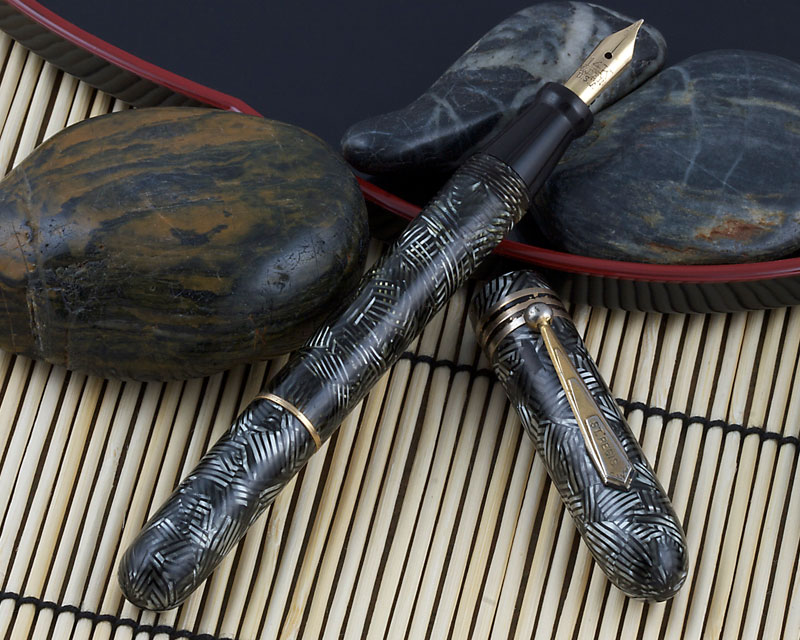
St. Regis Bulb Filler fountain pen open
The makers of the St. Regis Bulb Filler fountain pen knew they weren't competing in the big leagues. In the 1930s, the likely manufacture decade for this bluntly streamlined pen, there were hundreds of pen brands, most of them sold cheaply in five and dimes all over the USA. Many look identical except for the name stamped on the clip, to the point that one wonders if some of these budget brands were not all made by the same company.
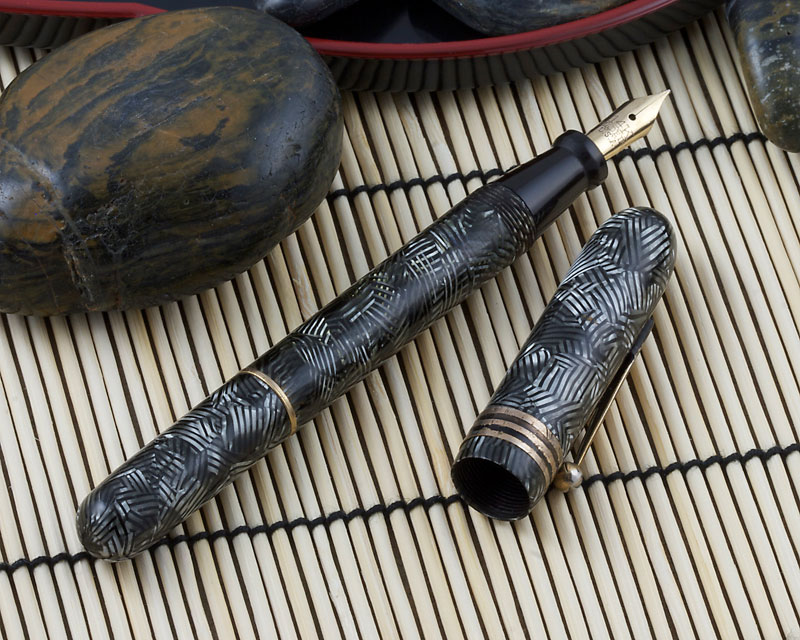
St. Regis Bulb Filler fountain pen open
I imagine that the makers of the St. Regis brand may have been from New York and wanted to bring the cachet of the St. Regis hotel, the first class Beaux Arts hotel on 55th Street and Fifth Avenue that opened in 1904. The St. Regis was built by Colonel John Jacob Astor IV, who died aboard the RMS Titanic on April 15, 1912. His vision was to give wealthy guests the luxury and refinement as if they were guests in a private home. According to the St. Regis hotel's own history on its web site, "Fresh flowers were brought in daily, an English-style butler and afternoon tea services were implemented and exclusive social gatherings such as a midnight supper created an air of grandeur inside the St. Regis that enthralled its guests." The hotel also served as regular accommodations for the rich and famous, such as Marlene Dietrich, William Paley, and Salvador Dali. This is a pretty lofty standard for a pretty low end pen brand.
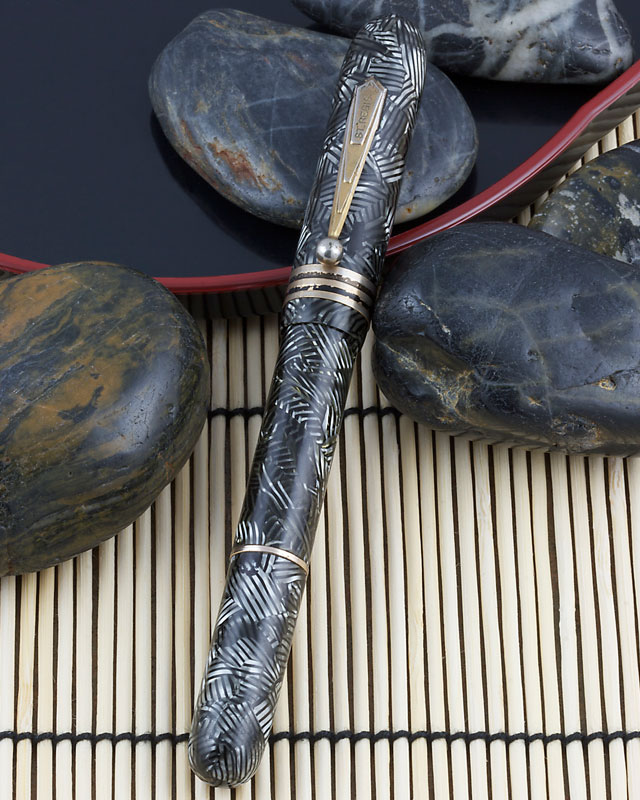
St. Regis Bulb Filler fountain pen closed
As it is, the St. Regis Bulb Filler fountain pen is decently made, with all the parts fitting flush and tight and showing no serious cut corners other than the very cheap gold plating job on the stepped clip and trim. The cap band may look like a three ring set, but it is actually a single wide band with two painted black stripes, now easier to see as much of the paint is chipping off. Since this pen came in a box of repair parts pens and had no nib, I can't speak to the original nib, but the feed is well made and centered correctly in the section, and I imagine the original equipment nib was probably a basic stainless steel type, though a gold plated nib would have fit the style of the pen with its gold plated trim. The feed has a long breather tube that runs nearly to the opening at the bottom of the barrel for the ink sac. A nice touch is the metal fitting for blind cap that also serves as the plug for the barrel. This is a quality fitting that gives the barrel a trim ring and holds the blind cap very securely. If I have a beef with this pen, other than the crummy plating, it's that the ink view barrel is hard to gauge with the crosshatch pattern in the celluloid, so unless held up to a really bright light, you really can't tell the remaining ink level.
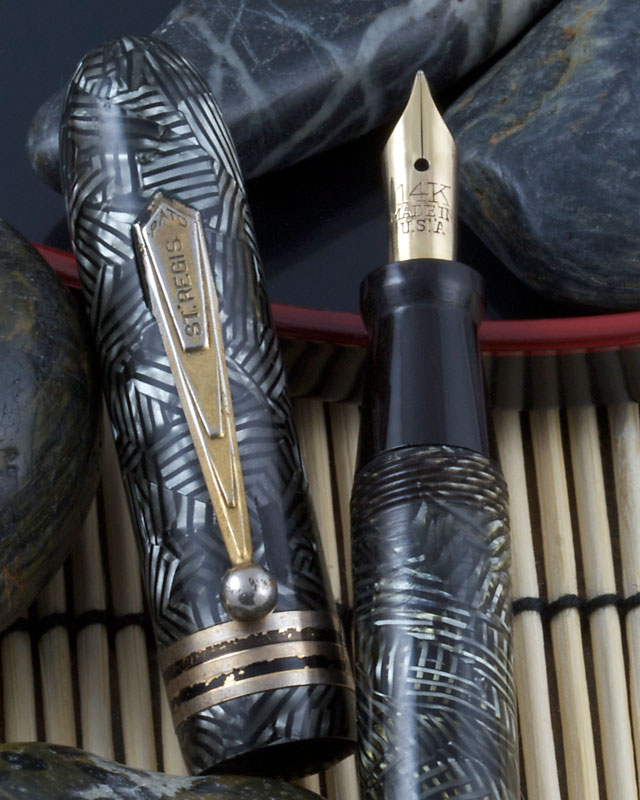
St. Regis Bulb Filler fountain pen cap and nib detail
One of the interesting aspects of the many lower tier brands is that they often used some of the most beautiful celluloid plastics, sometimes identical to those used on higher name brand pens, that indicates that the materials were not always exclusive single brand colors and patterns. This is no surprise during the Depression, when every pen maker was just trying to stay alive.
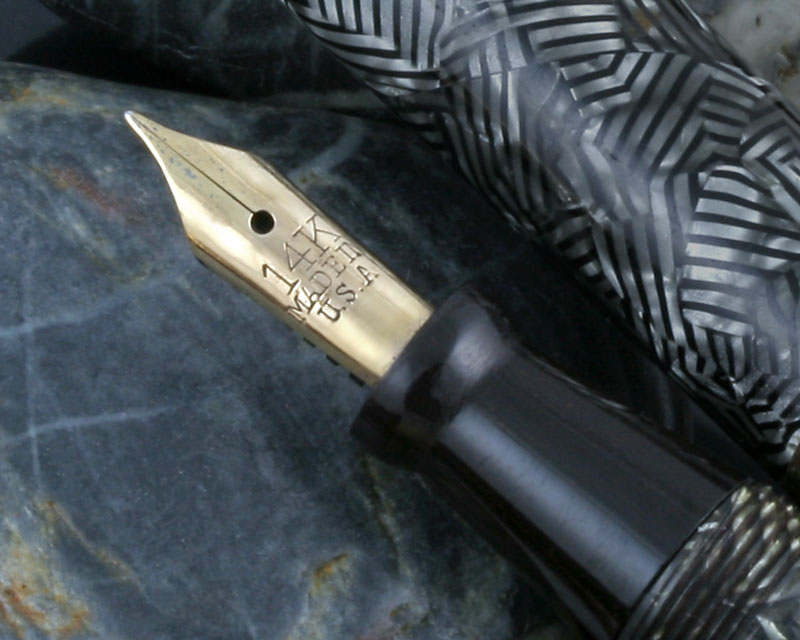
St. Regis Bulb Filler fountain pen nib detail
It's difficult to date the St. Regis Bulb Filler as I've been unable to find any pricing, catalog or advertising materials on the brand. The streamline shape dates the pen after 1929, when the Sheaffer Balance was introduced, and the gray crosshatch celluloid is nearly identical to a type used by Conklin in the mid 1930s. That's about as close as one can guess.
This St. Regis Bulb Filler is a standard size, yet lighter weight pen, weighing 0.6 ounce and being 5 3/16 inches long with the cap on and a very long 6 3/8 inches with the cap posted on the end of the barrel. The pen posts very securely and is comfortable with the cap posted or without. Cheap pens usually mean cheap plating, and this St. Regis is no exception. It's more gold tone than gold plate and I imagine much work with a buffing compound would easily take the rest of the plating off. As it is, this pen has held up quite nicely, though it does show the heavy plate loss and seen on similar pens. I would really have liked to have seen this pen new, as the gray celluloid is really attractive.
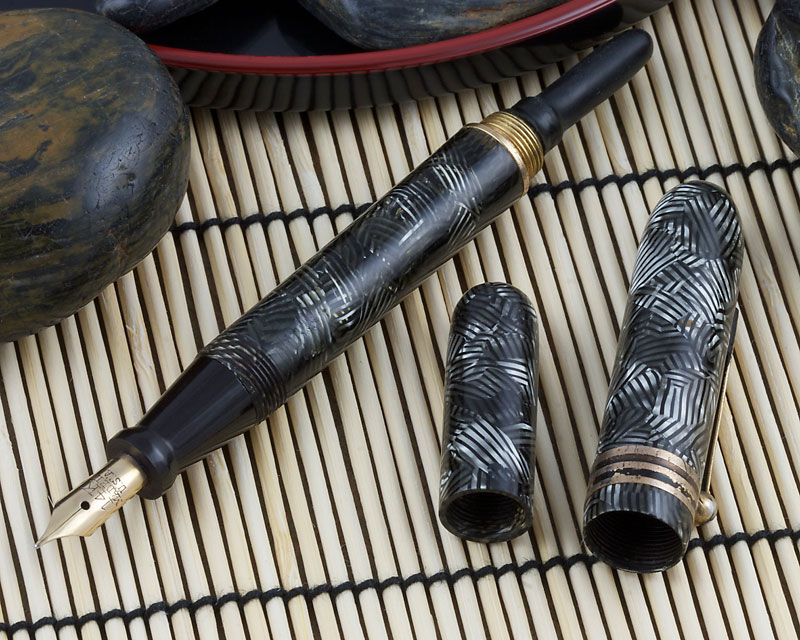
St. Regis Bulb Filler fountain pen open with blind cap removed showing ink sac
As with the larger Postal Reservoir Pen, patience is a virtue when filling the St. Regis Bulb Filler. Remove the blind cap, dunk the section in the ink, and start squeezing the ink sac, checking through the heavy cross hatch pattern celluloid to see the progress of the ink filling. It's not easy to gauge with this pen without a bright light, but it will fill quite full.
With the very smooth and wet writing medium 14 karat gold nib that was liberated from a beater Wearever Pacemaker, this pen is actually a pleasure to write with. That says a lot for Wearever Pacemakers, yes, but this is a much prettier and better made pen. I picked that particular nib as a replacement, as the feed on the St. Regis is about the same size as the clear feed on the Pacemaker, and it turns out to be a good fit. I don't have any other St. Regis pens to compare to, but I imagine the standard nib may have been one of the typical stainless steel "durium tipped" nibs seen on many cheapies. These are not bad nibs, generally good writers, but the Pacemaker nib is superior. The only other real restoration required was clearing off the fossilized ink sac and installing a replacement.
The St. Regis turned out to be a fun afternoon project, rescuing a nice pen from nibless oblivion and placing it back where it belongs: working.
Discuss / Recommend what you read on PenHero.com
Follow us on Twitter: PenHero
Add a link to PenHero.com on your blog:
(Copy & paste code)
Please only use the photo provided. Use of other photos requires permission.
The provided link photo will change as we update the site.
Comments on this article may be sent
to the author, Jim Mamoulides
PenHero.com Bibliography
